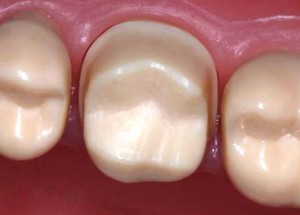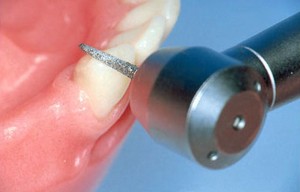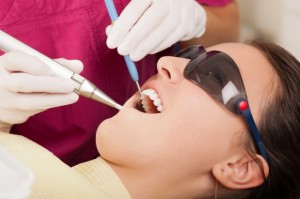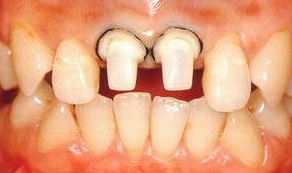Tooth turning for cermet

Preparation or grinding of teeth for cermet is a rather unpleasant procedure, which is required when prosthetics.
An exception to the rule is prosthetics on implants.
Turning (preparation) is one of the important stages in preparing teeth for prosthetics.
It is a removal of hard tooth tissues to smooth the surface.
Until recently, tooth preparation was quite lengthy and unpleasant.
Modern techniques and anesthetics have made the turning procedure completely painless and reduced the time it takes.
Do you always need turning
Unfortunately, despite the latest technology and advances in dentistry, it is not possible to miss the stage of preparation of teeth.
- In order for the crown to be firmly fixed on the tooth, it must adhere to it with maximum accuracy. The natural shape of the teeth is not ideal, their side walls are convex in shape, which excludes the possibility of creating a crown of this shape.
- As a result of grinding the enamel, the tooth surface becomes a regular shape, on which the crown can be easily fixed.
- In addition, the design itself has a certain thickness, which must be taken into account so that there is no discomfort in the oral cavity when eating and talking.
How to grind teeth for cermet

When grinding a tooth, the doctor removes tissues that are affected by caries from the surface of the teeth. This is done in order to prevent the development of complications after prosthetics.
- If a dead tooth is prepared, then there is no need for anesthesia, except when a special floss is used to move the gums.
- If the turning is carried out on a live tooth, then anesthesia is carried out without fail.
When preparing a tooth, its anatomical features and the possible reaction of soft tissues are taken into account.
Therefore, before the start of the procedure, an x-ray is taken in order to clearly represent the structure of the patient’s teeth, the topography of the tooth cavity, the thickness of the enamel walls, and the periodontal condition.
Features of the preparation:
- The quality of the preparation of teeth depends, first of all, on the qualifications of the dentist.
- The preparation is usually carried out with a diamond tool.
- To grind teeth under metal ceramics, they begin from the lateral surfaces, which eliminates damage to adjacent teeth, then evenly remove 2 mm hard tissues from all sides, leaving a ledge in the bottom of the tooth under the gum.
- The more tooth tissue removed, the lower the rotation speed of the boron. In some cases, the ledge is formed manually.
- During turning, to prevent burns, the pulp is cooled by water.
- In order to avoid injury to the pulp, the doctor seeks to maintain the thickness of the dentin at least 1 mm. The high functional and aesthetic result depends on the viability of the pulp.
- The grinding depth is determined using a diamond bur with a limiter, deep orientation grooves, periodontal probes and other devices.
- For reliable fixation of the structure, the walls of the stump should be rough.
- After fixing the crown, there should not be the slightest gap between the crown and stump to prevent the entry of saliva, food and bacteria.
- In patients under the age of 30, the preparation of a tooth under a ceramic-metal crown is carried out with great care. In case of danger of damage to the pulp, it is recommended to remove it to maintain aesthetics.
Video: “Preparation of incisors”
Complications
- The most unpleasant complication with improper turning is the opening of the tooth cavity.
- Even if the turning under the cermet is done very carefully, all the same, pulp irritation occurs in the form of vasodilation and the formation of edema.
All these side effects are reversible and soon pass without a trace.
Causes of pain after grinding
The procedure itself with adequate anesthesia is painless. But after the end of the action of the anesthetic drug, pain may appear in the prepared tooth and gum.
Possible causes of pain:
- If a live tooth is turned, then a very thin layer of hard tissue is left over the pulp and the prepared tooth will respond to acidic, cold and even touch. In this case, fixation of a temporary denture on the turned teeth or additional cementing of the surface of the thinned area is required.
- To make a turning with a step, the doctor needs a sufficient overview of the working area, especially when carrying out manipulations deeper than the gingival margin. To do this, the edge of the gum is pushed back with a special thread. This manipulation can cause swelling and tenderness of the soft tissues as a result of their compression. Normally, all these sensations disappear within one to two days.
- If a lot of time has passed after the preparation, then the appearance of pain may indicate the occurrence of periodontitis or pulpitis. Such a symptom should be a signal for an immediate visit to the dentist.
Methodologies
There are a number of techniques for turning teeth.
Ultrasound
Benefits of Ultrasonic Turning:
- Minimum pressure on the fabric of the working tips.
- Enamel and dentin do not overheat.
- Painless procedure.
- The absence of chips and microcracks on the walls of the pin.
- There is no negative effect on tooth tissue.
By laser

For preparation, pulsed lasers are used.
Their effect is that in the tooth tissue under the influence of a laser there is a strong heating of water. This leads to a violation of the integrity of enamel and dentin.
With the help of a water - air mixture, their microscopic particles are destroyed and removed.
Advantages of laser turning:
- Silent operation of the equipment.
- Weak tooth tissue heating.
- The presence of high safety procedures, since there are no rotating elements.
- High speed of preparation.
- Absence of chips and pin cracks.
- Lack of factors contributing to infection.
Tunneling
Turbine units are used to grind teeth, allowing you to adjust the speed of work, as well as metal or diamond tips.
The quality of such equipment has a direct impact on the result of turning, since long-used tools cause overheating of tooth tissues, which increases the risk of tooth decay.
With tunnel grinding, it is necessary to leave as much tooth tissue as possible.
The advantage of the technique is a clear prediction of the result and the ability to control the thickness of the removed tissue layer.
The disadvantages of the method:
- The possibility of overheating of the tissues and severe pain with insufficient analgesia.
- Soft tissue injury in violation of the procedure.
- The presence of a high risk of cracks and micro-chips of hard tissue when using low-quality tools.
Air abrasive method
An air mixture with abrasive powder is used, supplied at high pressure. Getting on the tooth enamel there is a small destruction and removal of dental dust.
Benefits:
- High speed and ease of procedure.
- Lack of pain and heating of tooth tissues.
- When preparing live teeth, the absence of vibration has a positive effect on the condition of the pulp.
- Preservation of tooth volume in the maximum quantity.
Chemical Turning Method
It consists in the use of a chemical substance that contributes to the destruction of enamel and dentin.
The disadvantage is the duration of the procedure. Sometimes the duration of exposure reaches thirty minutes.
Advantages:
- No need to anesthetize.
- No thermal damage to the tooth is observed.
- On the enamel does not occur small cracks and chips.
- The presence of psychological comfort due to the lack of sound drill.
Types of ledges when turning
For reliable fixation of the crown, it is necessary to turn with a ledge.
The most common types of tooth turning are:

- A knife-like ledge with a width of 3-4 mm is a commonly used species. It is used for all-metal crowns and is optimally suited for turning oblique teeth.
- A grooved rounded ledge allows you to save tooth tissue in the maximum amount. Its width is 0.8 - 1.2 mm. This is a classic option for cermets.
- The shoulder ledge is the most uneconomical type of turning requiring depulpation. The width of the step is 2 mm. However, such a ledge allows you to fix the crowns more firmly and has a higher aesthetic performance.
Rules for turning on a live tooth
- The preparation is carried out under anesthesia, slowly intermittently and with sufficient water.
- For turning it is necessary to use a new boron and a special tip.
- The application of a special coating that prevents the infection from entering the nerve and the further development of the inflammatory process.
- Immediately, immediately after the procedure, it is necessary to install temporary crowns on the turned teeth, which are fixed on a special cement containing an antiseptic.
Advantages of cermets on live teeth
- Living teeth are stronger than depuluted and will not break with time.
- Living teeth are less prone to caries.
- No need to install pins.
- Reduced patient costs for prosthetics. The patient does not need to additionally spend money on carrying out depulpation, which is not cheap.
- Removing a nerve is an irreversible procedure.